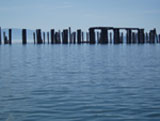Rivers & Fisheries
“And an ingenious Spaniard says, that rivers and the inhabitants of the watery element were made for wise men to contemplate, and fools pass by without consideration.”
- Izaak Walton (1593-1683)
Free flowing rivers in North America are increasingly rare, as most large rivers are dammed to generate power, supply water to domestic, industrial, and agricultural users, and prevent flooding of cities and towns. Much of the Flathead River system, however, is unimpeded from the headwaters to Flathead Lake. The North Fork and Middle Fork of the Flathead River are free of major dams. The free-flowing North Fork provides some of the most significant habitat for native bull trout and westslope cutthroat trout in the watershed. The major dams in the Flathead Watershed impound the South Fork of the Flathead River at Hungry Horse Dam, the Flathead River downstream of Flathead Lake at Kerr Dam, and the Bigfork Dam on the Swan River about 1 mile upstream from Flathead Lake.
Bigfork and Hungry Horse dams effectively block fish passage from Flathead Lake to the upper river reaches, subdividing the fisheries of the Flathead. The North and Middle Forks and the portion of the South Fork of the Flathead River above Hungry Horse Reservoir are designated as “Wild and Scenic Rivers.” Under the authority of the Wild and Scenic Rivers Act of 1968, a river or river section may be so designated by the U.S. Congress or the Secretary of the Interior. Designation as a wild and scenic river does not generally halt development or use of a river but exists to preserve the character of a river in its free flowing condition, undammed and unimproved. These portions of the Flathead River are part of the landscapes of Glacier National Park, and the Bob Marshall and Great Bear Wilderness areas.
 |
| Figure 4.4: Snyder Creek Source: A painting by Mark Ogle |
As glaciers receded some ten thousand years ago, meltwater began to form the fish habitat of the Flathead Watershed. Rivers and streams created floodplain areas, riparian corridors and wetlands critical for water quality, wildlife habitat, and fisheries habitat. The most notable native fish species found in the watershed prior to 1890 included bull trout, westslope cutthroat trout, mountain and pygmy whitefish, northern pikeminnow, sculpins and suckers. Once railroads provided the system of transportation between fish hatcheries and Flathead Lake and other lakes, non-native fish species were introduced into the watershed in the hope of boosting the game population and the economy.
The introduction of non-native fish more than doubled the species diversity in Flathead Lake, negatively impacting native fish by increasing competition for available resources. Lake whitefish (introduced in 1890), lake trout (introduced in 1905), yellow perch (introduced in 1910), and kokanee (introduced in 1916 and since crashed) became major sport fish species in the area.
Today fisheries managers place greater emphasis on preserving and improving native and wild fisheries, and have increased education, regulation, and enforcement efforts to support their goals. Fisheries biologists continue to study the complex aquatic systems in the Flathead Watershed, working to protect native fish while maintaining the economic value of the recreational fisheries. Native fish such as bulltrout and westslope cutthroat trout require cold, clear, complex, and connected waters for survival. Maintaining these requirements is an ongoing challenge in the watershed where development threatens this important habitat.


